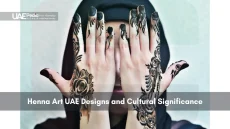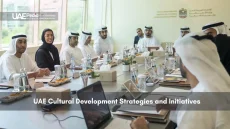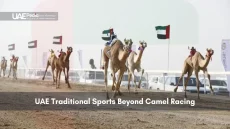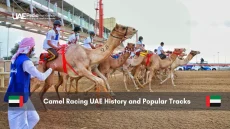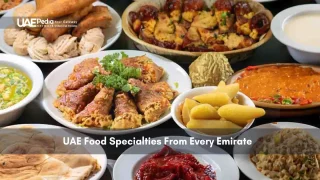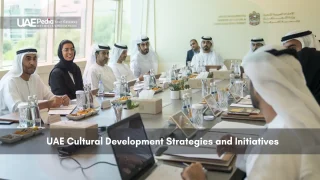What if the world’s most futuristic skyline stood just steps from centuries-old traditions? The United Arab Emirates quietly defies expectations, blending pearl-diving history with avant-garde architecture. A growing number of travelers now seek authentic connections here—sipping Arabic coffee in a Bedouin-style majlis or tracing calligraphy patterns in Sharjah’s art districts.
Abu Dhabi’s Louvre Museum alone welcomes over a million visitors yearly, but this country’s heart beats beyond gallery walls. Families gather for date harvest festivals, chefs revive recipes using saffron traded along ancient routes, and storytellers share tales under star-lit desert skies. Even the government’s latest initiatives—like Al Ain’s UNESCO-recognized oases—prioritize preserving these living traditions.
You’ll discover how everyday moments here carry cultural weight. The scent of burning oud wood in souqs, the rhythm of traditional Ayala dances, and the intricate geometry of mosques all whisper stories of resilience and innovation. Modern Emiratis proudly wear kanduras not as costumes, but as threads connecting past and future.
- Explore how ancient ports evolved into hubs for global arts and innovation
- Uncover hidden gems beyond famous landmarks through local-led tours
- Learn respectful ways to engage with traditions during seasonal festivals
An Overview of UAE Cultural Tourism
Did you know over 200 nationalities coexist in a land smaller than Maine? This country thrives as a living mosaic—where Bedouin hospitality meets Mumbai’s spice markets and Tokyo’s neon glow. Sharjah wears its “Cultural Capital of the Arab World” title proudly, while Al Ain’s palm-fringed oases whisper tales from UNESCO-protected sands.
Cultural Diversity and Historical Roots
Walk through Abu Dhabi’s Louvre-inspired galleries, then trace 3,000-year-old irrigation systems. The blend feels natural here. Bedouin survival skills—like reading stars for navigation—still shape desert festivals. Yet glass towers rise where pearl divers once anchored dhows.
The Role of Heritage and Traditions
Friday markets buzz with henna artists and frankincense vendors. Religious festivals like Eid see families host lavish family gatherings, sharing stories over harees (wheat-and-meat porridge). Government initiatives preserve everything from falconry to date farms, ensuring traditions aren’t museum pieces but living threads.
This country’s secret? Its past fuels the future. Heritage sites double as concert venues. Old forts host AI exhibitions. Even the dirham currency features calligraphy alongside microchip motifs. Every corner invites you to taste, touch, and hear layers of history still being written.
Understanding Emirati Heritage and Traditions
Imagine stepping into a home where the aroma of cardamom-spiced coffee mingles with warm greetings of “As-salamu alaykum”. This harmony of hospitality and ritual defines daily life here. Five times a day, the call to prayer echoes across cities—not as a relic, but a rhythm connecting communities.
Customs, Religion, and Communal Practices
Greetings matter. Responding “Wa alaykum as-salam” when welcomed shows respect. At meals, use your right hand—it’s tradition. During Ramadan, sunset iftar feasts turn strangers into family. Even coffee pours follow rules: servers hold the dallah pot high, filling cups halfway to prevent rushing conversations.
Influential Festivals and Celebrations
Winter sparks celebration. The Sheikh Zayed Heritage Festival transforms desert sands into stages for camel races and oud musicians. Locals call it “a journey through our roots”. National Day sees rooftops draped in red, green, and white—every parade float tells stories of the country’s development.
Visitors often marvel at how heritage shapes modern life. Markets buzz with henna artists etching floral patterns while kids snap Instagram stories. These moments reveal why traditions endure: they’re not frozen in history, but breathing parts of today’s society.
Diving into Local Arts and Culinary Experiences
Ever tasted a dish where saffron threads tell stories of desert caravans? Here, artistry isn’t confined to galleries—it’s woven into fabric patterns, etched onto skin, and simmered in clay pots. This country’s creative pulse thrives where ancient techniques meet neon-lit innovation.
Traditional Art Forms and Modern Expressions
Sadu weaving—once used for Bedouin tents—now adorns luxury handbags in Dubai boutiques. Henna artists swap tribal motifs for geometric designs, blending heritage with Instagram trends. “Our hands remember the old ways, but our eyes see new possibilities,” shares a Sharjah-based artisan.
Arabic calligraphy leaps off parchment, scaling skyscrapers as light installations. Galleries showcase AI-generated art inspired by pearl diving songs. Even the humble majlis (sitting area) gets a refresh—some feature 3D-printed furniture shaped like desert dunes.
Emirati Cuisine: Historical Flavors and Modern Dishes
Machboos (spiced rice with meat) whispers of spice routes, while harees (wheat porridge) recalls communal feasts under stars. Dates aren’t just snacks—they’re stuffed with orange zest or dipped in chocolate at avant-garde cafes. Chefs now reinvent classics: think camel milk cappuccinos or saffron-infused cheesecake.
For authentic bites, seek heritage restaurants where recipes pass through generations. Pro tip: Try luqaimat (fried dough balls) drizzled with date syrup—it’s like tasting golden-hour sunlight. Every meal here becomes a dialogue between dune-crossing ancestors and tomorrow’s culinary pioneers.
Preserving History through Museums and Heritage Villages
History doesn’t gather dust here—it dances in glass-walled galleries and whispers through reconstructed souqs. Across Abu Dhabi and beyond, institutions and villages act as time capsules where ancient traditions meet cutting-edge curation. Let’s explore how these spaces turn artifacts into conversations.
Iconic Museums and Cultural Institutions
The Louvre Abu Dhabi redefines museum-going with its rain-of-light dome, where 23 permanent galleries span millennia. Nearby, the upcoming Natural History Museum will showcase fossils from local deserts alongside interactive climate exhibits. These aren’t just display cases—they’re bridges between eras.
| Museum | Unique Feature | Historical Connection | Visitor Experience |
|---|---|---|---|
| Louvre Abu Dhabi | Floating dome design | Global civilizations dialogue | Guided sunset tours |
| Zayed National Museum | Falcon-wing architecture | Founding Father’s legacy | Oral history recordings |
| Guggenheim Abu Dhabi | Contemporary Middle Eastern art | Modern regional narratives | Artist workshops |
Heritage Villages: A Glimpse into the Past
Al Ain’s UNESCO-listed oases host villages where date-palm barasti huts stand frozen in time. Watch artisans weave palm fronds into baskets using techniques unchanged for centuries. Don’t miss the reconstructed forts and castles that once guarded trade routes.
Pro tip: Visit heritage sites early morning or late afternoon to avoid crowds. Many offer hands-on activities—try grinding coffee beans or shaping clay pots. As one curator told us: “We’re not preserving objects. We’re keeping stories alive for tomorrow’s storytellers.”
Navigating Cultural Norms and Hospitality
Ever wondered why a simple hand gesture could make or break a conversation here? Local customs reveal deeper values – respect, generosity, and community. Understanding these unspoken rules transforms casual encounters into meaningful exchanges.
Language, Etiquette, and Dining Customs
Start with “Salaam aleikum” (Peace be upon you) when greeting locals. The response “Wa aleikum a-salaam” opens doors – literally. At meals, use your right hand for passing dishes. Leaving a bite on your plate signals satisfaction, not wastefulness.
Communal dining thrives here. Sharing a platter of lamb machboos? Take modest portions and compliment the host. One chef confided: “When guests enjoy our food, they honor generations of spice traders.”
| Etiquette Point | Cultural Significance | Visitor Tip |
|---|---|---|
| Greetings | Shows respect for Islamic traditions | Practice basic Arabic phrases |
| Dining | Right hand use honors cleanliness customs | Accept coffee refills until gently shaking cup |
| Dress Code | Modesty reflects local values | Carry scarf for mosque visits |
| Gift Giving | Symbolizes friendship | Offer with both hands |
When visiting Abu Dhabi’s Sheikh Zayed Grand Mosque, women should cover hair with loose scarves. Men avoid shorts. These rules aren’t restrictive – they’re invitations to participate thoughtfully.
Festivals like Ramadan deepen connections. Join sunset iftar meals after sunset, but avoid eating publicly during daylight hours. A shopkeeper in Abu Dhabi advises: “Ask questions politely – we love sharing our lifestyle with curious visitors.”
Mastering these nuances turns sightseeing into cultural exchanges. You’ll leave with more than photos – you’ll carry stories of shared laughter over cardamom coffee and the warmth of genuine hospitality.
Experiencing Traditional Sports and Contemporary Recreational Activities
What if your next vacation included racing across dunes on a camel? This region thrives where ancient athleticism meets modern adventure. From desert stadiums hosting robot-jockeyed camel races to urban parks teaching falcon handling, every activity tells a story of adaptation.
Traditional Sports: Falconry, Camel Racing, and More
Falconry isn’t just sport here—it’s poetry in motion. “We train birds like family,” says a third-generation falconer near Abu Dhabi. Watch these raptors dive at 240 mph during competitions, their GPS trackers blending Bedouin wisdom with tech.
Camel racing evolved too. Gone are child jockeys—replaced by solar-powered robots guiding 18mph sprints. Families cheer from trackside SUVs, snacking on dates while camels kick up golden dust. Check organized sports initiatives for race schedules.
Family-friendly Cultural Tours and Experiences
Swap screens for sand at Al Wathba’s heritage camps. Kids learn to brave camel hair ropes while parents sip gahwa (Arabic coffee). Evening tours reveal how stars guided nomadic hunters—now they’re part of astronomy workshops.
| Tour | Highlights | Age Range |
|---|---|---|
| Desert Skills 101 | Archery, dune navigation | 8+ |
| Falconry Basics | Glove training, feeding | 6+ |
| Date Farm Cycle | Harvesting, syrup-making | All ages |
Pro tip: Visit Al Ain Oasis during winter festivals. You’ll see camel beauty pageants—judges assess eyelash length and hump symmetry. It’s like Westminster Dog Show meets Lawrence of Arabia.
Final Reflections on UAE Cultural Tourism Experiences
Every sunset here paints a new story—one where ancient souq shadows stretch toward neon-lit skylines. This land thrives on contrasts: sipping cardamom coffee in a Bedouin tent one hour, marveling at AI-driven art installations the next. What unites these moments? A deep pride in heritage that fuels tomorrow’s innovations.
Our journey revealed how traditions shape modern life. From saffron-infused desserts to robot-jockeyed camel races, every experience connects past and future. Museums don’t just display artifacts—they spark dialogues across eras. Festivals turn strangers into temporary family, sharing stories under the same stars that guided nomadic ancestors.
To truly grasp this nation’s identity, blend historical exploration with contemporary curiosity. Let henna artists trace your palm while discussing 3D-printed architecture. Navigate dunes where falconers now use GPS trackers. These layers create a living mosaic no guidebook can fully capture.
Pack your questions alongside sunscreen. Whether you’re tasting luqaimat dough balls or decoding calligraphy on skyscrapers, each interaction becomes part of your own unfolding narrative. Ready to write the next chapter? The Emirates await—not as spectators, but as co-authors of your adventure.
Warmth is woven into local traditions—think fragrant Arabic coffee served in a majlis (gathering space) or dates offered as a welcome. Respectful gestures like dressing modestly in historic areas or using your right hand for meals deepen connections. It’s less about rules, more about shared smiles.
Don’t miss Dubai Shopping Festival (January-February) for heritage performances alongside deals, or Sharjah Light Festival (February), where landmarks glow with Emirati storytelling. Ramadan evenings also offer unique iftar feasts and night markets—check lunar calendars!
Head to Al Ain Oasis—a UNESCO site with falconry displays and palm-frond weaving workshops. Liwa Date Festival (July) celebrates desert agriculture, while Sir Bani Yas Island blends wildlife safaris with archaeological sites revealing ancient trade routes.
Places like Louvre Abu Dhabi use interactive galleries to connect local pearl diving history with global art. Etihad Museum in Dubai employs multimedia to chart the nation’s formation—perfect for context before exploring heritage villages like Hatta or Al Jazirah Al Hamra.
Join a Al Khayma Heritage Restaurant cooking class in Dubai to make machboos (spiced rice) or luqaimat (sweet dumplings). Food trucks in Al Seef district reimagine classics—try camel milk ice cream or saffron-infused karak chai!
A> Yes! Shoulders/knees covered for all at mosques like Sheikh Zayed Grand Mosque. Remove shoes before entering carpeted areas. Photography? Usually fine, but avoid worshippers during prayer. Guides often provide abayas—embrace it as part of the journey.
A: Sharjah Safari pairs wildlife with African-Emirati trade history. Abu Dhabi Falcon Hospital offers hands-on encounters, while Dubai’s Al Fahidi Historical District has shadow puppet shows and calligraphy workshops—perfect for curious kids (and adults!).




